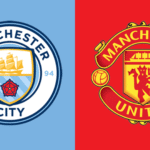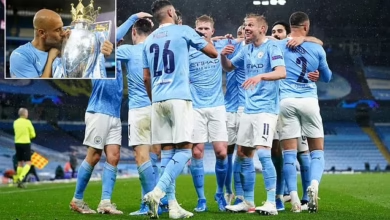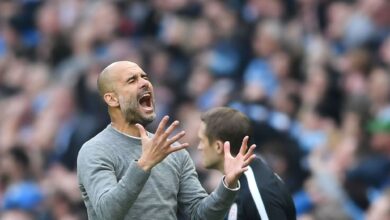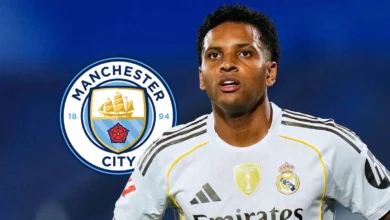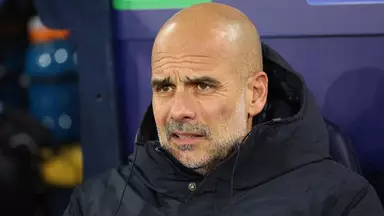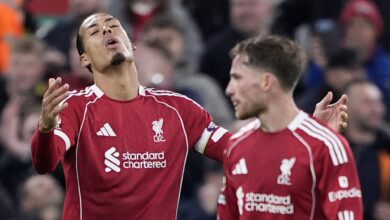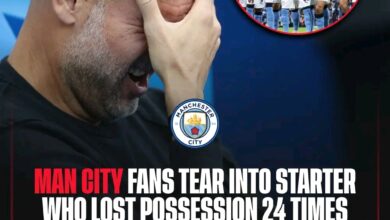Thierry Henry’s Warning: Why Hugo Viana’s Dumfries Pursuit Could Be Manchester City’s Next Big Mistake

The summer transfer window has brought significant changes to Manchester City’s hierarchy, with Hugo Viana stepping into the substantial shoes left by Txiki Begiristain as Director of Football. The Portuguese executive has wasted no time in making his mark at the Etihad Stadium, orchestrating a series of high-profile acquisitions that have caught the attention of the football world. However, as City reportedly enter advanced negotiations for Inter Milan’s Denzel Dumfries, a prescient warning from Arsenal legend Thierry Henry suggests that Viana might be about to make a costly tactical miscalculation that could undermine Pep Guardiola’s carefully constructed system.
Taking over from Begiristain was never going to be an easy task. The Spaniard’s 13-year tenure at Manchester City was marked by transformative decisions that reshaped the club’s destiny. From convincing Pep Guardiola to leave Barcelona for Manchester to orchestrating the signings of generational talents like Sergio Aguero, Begiristain’s legacy at City is virtually unmatched in modern football administration. His departure left a void that many questioned could be adequately filled.
However, Viana has approached his new role with characteristic Portuguese pragmatism and ambition. The former Sporting CP executive has already demonstrated his ability to identify and secure top-tier talent, investing approximately £108 million in three carefully selected players who address specific needs within Guardiola’s squad. The acquisition of Rayan Cherki from Lyon brought creative flair and unpredictability to City’s attacking third, while Tijjani Reijnders from AC Milan added technical sophistication and tactical versatility to their midfield options. Perhaps most significantly, the signing of Rayan Ait-Nouri from Wolverhampton Wanderers addressed City’s need for pace and attacking thrust down the left flank.
These signings reflect a clear understanding of Guardiola’s tactical preferences and the modern game’s demands. Each player possesses the technical ability, tactical intelligence, and physical attributes necessary to thrive in City’s high-intensity, possession-based system. The investments have been strategic rather than flashy, focusing on players who can seamlessly integrate into the existing framework while adding new dimensions to City’s play.
The success of these early transfers has established Viana’s credibility within the club and among City supporters. His ability to identify players who fit both the tactical system and the club’s cultural values has been particularly impressive. However, the true test of any Director of Football comes not just in successful signings, but in avoiding costly mistakes that can disrupt team harmony and tactical cohesion.
With Kyle Walker’s surprising departure to Burnley, Manchester City find themselves in need of a new right-back. Walker’s departure was unexpected, given his importance to Guardiola’s system and his relatively young age for a defender. His pace, attacking threat, and defensive solidity made him an integral part of City’s success over recent seasons. Finding an adequate replacement was always going to be challenging, but the task becomes even more complex when considering the specific tactical requirements of playing right-back in Guardiola’s system.
Enter Denzel Dumfries, the Dutch international who has become Inter Milan’s most potent attacking weapon from the right flank. According to reports from Football Transfers, Manchester City are now in advanced discussions with Inter Milan regarding a potential transfer for the 29-year-old. The deal appears financially attractive, with Dumfries possessing a €25 million (£22 million) release clause that remains active until July 15th. For a player of his caliber and proven track record, this represents potentially excellent value in today’s inflated transfer market.
Dumfries’ statistical record at Inter Milan is undeniably impressive. In 179 appearances for the Nerazzurri, he has contributed 22 goals and 26 assists, numbers that would be exceptional for any attacking player, let alone a defender. His ability to create chances, score crucial goals, and provide consistent attacking threat has made him one of Serie A’s most feared wing-backs. His performances in the UEFA Champions League have been particularly noteworthy, with memorable displays against Barcelona showcasing his ability to influence matches at the highest level.
The Dutchman’s physical attributes are equally impressive. Standing at 6’2″ with exceptional pace and stamina, he possesses the athletic gifts necessary to excel in the Premier League’s demanding environment. His crossing ability is precise, his shooting powerful, and his defensive positioning generally sound. On paper, he appears to be everything Manchester City could want in a right-back replacement for Walker. However, the critical question remains: would Dumfries be the right fit for Guardiola’s tactical system? This is where Thierry Henry’s earlier analysis becomes particularly relevant and potentially prophetic.
In May 2023, following Inter Milan’s dominant 2-0 victory over AC Milan in the first leg of their UEFA Champions League semi-final, Thierry Henry provided analysis that now seems remarkably prescient given Manchester City’s current interest in Dumfries. Speaking to CBS Sports, Henry identified the key tactical elements that make Dumfries so effective for Inter Milan while simultaneously highlighting why these same elements might not translate well to Manchester City’s system.
“Their wing-backs are always high and wide to try to use the width of the field, and they do that against any team,” Henry observed. “It’s not like a Man City way of possessing the ball, we all know that, but when they go and put pressure, the wing-backs are really high in putting pressure.”
This analysis cuts to the heart of the potential issue with Dumfries at Manchester City. At Inter Milan, the Dutchman operates in a 3-5-2 formation that specifically maximizes his attacking contributions while providing adequate defensive cover through the three center-backs. In this system, Dumfries is encouraged to push high up the pitch, stretch the opposition defense, and create width in the final third. The tactical setup allows him to function almost as an auxiliary winger, with the freedom to join attacks without compromising the team’s defensive stability.
Manchester City’s system, by contrast, typically employs a 4-3-2-1 formation that places different demands on the full-backs. While Guardiola’s full-backs are certainly expected to contribute to attacks, they also need to maintain defensive discipline and tactical awareness that might constrain Dumfries’ natural attacking instincts. The Catalan coach’s preference for possession-based football requires full-backs who can not only attack but also contribute to the patient build-up play that characterizes City’s approach.
Henry’s observation about Inter Milan’s approach not being “like a Man City way of possessing the ball” is particularly significant. City’s possession-based system requires players who are comfortable with extended periods of ball circulation, patient build-up play, and the tactical discipline to maintain their positions even when attacking opportunities arise. This contrasts sharply with Inter Milan’s more direct approach, which allows Dumfries to make forward runs and create chances through pace and physicality rather than intricate passing combinations.
The fundamental difference in tactical philosophy could leave Dumfries feeling constrained and unable to express his best qualities. His most effective performances for Inter Milan have come when he has the freedom to push forward, stretch the opposition, and create chances through his pace and crossing ability. In City’s more structured system, he might find himself having to prioritize positional discipline over attacking freedom, potentially diminishing his effectiveness.
The distinction between wing-back and full-back might seem subtle to casual observers, but it represents a fundamental difference in tactical role and responsibility. Dumfries has excelled as a wing-back, a position that emphasizes attacking contribution while relying on additional defensive support from the center-backs. This role allows him to focus primarily on creating chances, scoring goals, and providing width in the final third.
A traditional full-back, however, must balance attacking and defensive responsibilities more evenly. They need to track back quickly when possession is lost, maintain defensive shape during sustained opposition attacks, and contribute to the team’s overall tactical structure. While modern full-backs are expected to attack, they cannot afford to abandon their defensive duties in pursuit of forward play.
Guardiola’s system places particular demands on full-backs that go beyond simple attacking and defending. City’s full-backs are expected to contribute to the team’s possession-based approach, making short passes, maintaining possession under pressure, and providing tactical flexibility by moving into midfield when required. This requires a different skill set and tactical understanding compared to the more direct approach favored by Inter Milan.
The positional demands of playing full-back in Guardiola’s system could potentially stifle Dumfries’ natural attacking instincts. His best performances have come when he has been given the freedom to make forward runs, create chances through pace and crossing, and contribute goals from advanced positions. In a more structured full-back role, he might find himself having to prioritize defensive responsibilities over attacking freedom, potentially reducing his effectiveness.
Furthermore, the tactical discipline required to play full-back in City’s system might not suit Dumfries’ playing style. His most memorable performances have been characterized by aggressive forward runs, direct attacking play, and the ability to create chances through individual brilliance rather than tactical patience. This approach might not mesh well with City’s preference for patient build-up play and collective tactical execution.
Pep Guardiola’s tactical innovations have consistently pushed the boundaries of modern football, and his use of inverted full-backs represents one of his most influential contributions to the game. The concept, which involves full-backs moving into central midfield positions during possession phases, has been widely adopted by clubs across Europe and has fundamentally changed how teams approach the full-back position.
The inverted full-back system requires players with exceptional tactical intelligence, positional awareness, and technical ability. Players like Joao Cancelo, Oleksandr Zinchenko, and Kyle Walker have all successfully adapted to this role, demonstrating the versatility and tactical understanding necessary to excel in Guardiola’s system. The success of this approach has influenced numerous other clubs, with Arsenal and Chelsea among those adopting similar tactical concepts.
However, the inverted full-back system places specific demands on players that might not suit Dumfries’ natural playing style. The role requires patience, tactical discipline, and the ability to contribute to possession-based play rather than direct attacking runs. Players must be comfortable operating in central areas, making short passes under pressure, and maintaining positional discipline even when attacking opportunities arise.
Dumfries’ strengths lie in his pace, crossing ability, and direct attacking play rather than the tactical sophistication required for the inverted full-back role. His best performances have come when he has been given the freedom to make forward runs, stretch the opposition defense, and create chances through individual brilliance. The constraints of the inverted full-back system might prevent him from expressing these qualities effectively.
The tactical evolution of Guardiola’s approach suggests that he values adaptability and tactical intelligence over pure attacking threat from his full-backs. This preference for tactical flexibility over individual brilliance could make Dumfries a poor fit for City’s system, regardless of his undeniable individual qualities.
The signing of Rayan Ait-Nouri adds another layer of complexity to Manchester City’s pursuit of Dumfries. The Algerian international is known for his attacking prowess, pace, and ability to create chances from the left flank. His addition to the squad suggests that City are looking to add more attacking threat from their full-back positions, which might support the logic behind pursuing Dumfries.
However, having two highly attacking full-backs could potentially create tactical imbalances that undermine City’s defensive stability. Guardiola’s system typically relies on at least one full-back maintaining defensive discipline while the other pushes forward. If both Ait-Nouri and Dumfries are encouraged to attack simultaneously, City could find themselves vulnerable to counter-attacks and defensive transitions.
The tactical balance between the two flanks is crucial to City’s success. Guardiola has traditionally preferred to have complementary full-backs who can provide different tactical options depending on the game situation. Having two similar attacking full-backs might reduce the team’s tactical flexibility and create predictability in their approach.
Furthermore, the integration of two new attacking full-backs simultaneously could disrupt the team’s defensive organization. Building understanding and tactical cohesion between defenders takes time, and introducing two new players in similar positions might create confusion and communication issues that could affect the team’s overall performance.
The potential tactical imbalance created by having two attacking full-backs might also affect City’s midfield structure. If both full-backs are pushing forward simultaneously, the midfield might need to provide additional defensive cover, potentially affecting the team’s attacking creativity and ball progression through the center of the pitch.
Manchester City’s recent transfer history includes several examples of players who struggled to adapt to Guardiola’s tactical demands despite possessing obvious individual qualities. The case of Joao Cancelo, who initially struggled before eventually finding his role in the system, demonstrates the importance of tactical fit over individual ability.
The experience with players like Angelino, who possessed excellent attacking qualities but struggled with the defensive demands of the full-back position, highlights the risks of prioritizing attacking threat over tactical suitability. These examples suggest that City should prioritize tactical fit and adaptability over pure individual brilliance when selecting new players.
The club’s most successful signings under Guardiola have been players who possessed the tactical intelligence and adaptability to excel in his system. Players like Ruben Dias, Rodri, and Bernardo Silva have all demonstrated the ability to adapt their playing style to meet the tactical demands of the system while maintaining their individual qualities.
This suggests that City should focus on identifying players who possess the tactical intelligence and adaptability necessary to excel in Guardiola’s system, rather than pursuing players based purely on their individual statistics and attacking threat. The emphasis should be on finding players who can contribute to the team’s tactical coherence while adding their own unique qualities to the squad.
The pursuit of Dumfries represents a potential departure from this approach, prioritizing individual attacking threat over tactical suitability. This could result in another expensive mistake that disrupts the team’s tactical balance and fails to address the specific needs of the position.
Thierry Henry’s analysis of Denzel Dumfries’ role at Inter Milan provides a clear warning about the potential risks of signing the Dutch international for Manchester City. While Dumfries is undoubtedly a talented player with impressive statistics and proven ability at the highest level, his tactical suitability for Guardiola’s system remains questionable.
The fundamental difference between Inter Milan’s wing-back system and Manchester City’s full-back requirements could leave Dumfries struggling to adapt to his new role. His strengths in direct attacking play and pace might be constrained by the tactical discipline required in City’s possession-based system, potentially reducing his effectiveness and creating tactical imbalances.
Hugo Viana’s early success as Director of Football has been built on identifying players who fit both the tactical system and the club’s cultural values. The pursuit of Dumfries represents a potential departure from this approach, prioritizing individual attacking threat over tactical suitability. This could result in an expensive mistake that disrupts the team’s tactical balance and fails to address the specific needs of the position.
The warning signs are clear, and Thierry Henry’s prescient analysis provides a roadmap for understanding why this transfer might not deliver the expected results. Manchester City would be wise to heed these warnings and focus on identifying players who possess the tactical intelligence and adaptability necessary to excel in Guardiola’s system, rather than pursuing players based purely on their individual statistics and attacking threat.
The £22 million investment in Dumfries might seem modest by today’s standards, but the potential tactical disruption and system imbalance could prove far more costly than the transfer fee suggests. In a sport where tactical coherence and system suitability often matter more than individual brilliance, Manchester City should carefully consider whether Dumfries represents the right solution to their right-back dilemma.



